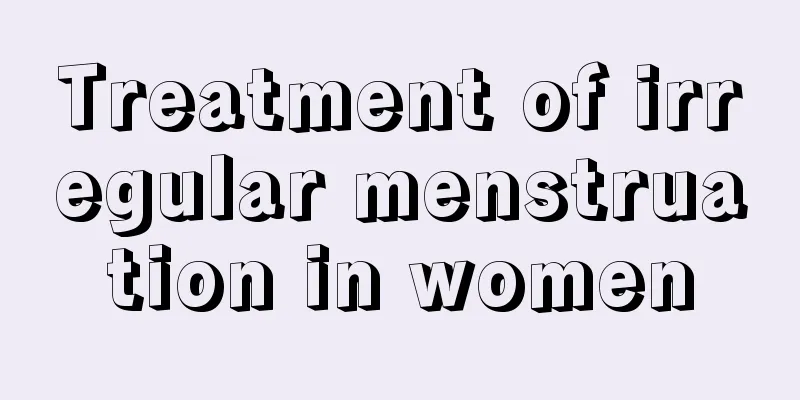How to get pregnant with endometriosis? The symptoms are actually these

|
Endometriosis is a common gynecological disease. Once you suffer from this disease, it is difficult to get pregnant and you may even become infertile for life. From a clinical perspective, if the symptoms are not very serious, you can choose to conceive naturally. If they are serious, it is best to treat them through medication, laparoscopic technology, etc., which have good results. 1. Symptoms 1. Dysmenorrhea Dysmenorrhea is the most typical symptom of endometriosis. It can occur before, during, or after your period. In severe stages, the pain is unbearable and increasing the dosage of analgesics may not even be effective. The pain is caused by internal bleeding from endometriosis stimulating local tissue inflammatory response. Endometriosis lesions secrete more prostaglandins, which causes uterine muscle contractions and makes dysmenorrhea more pronounced. After menstruation, bleeding stops and pain is relieved. 2. Abnormal menstruation It may present as heavy menstruation or irregular menstrual cycles. Most of the menstrual abnormalities are related to the impact of endometriosis on ovarian function. Patients with endometriosis may experience ovarian dysfunction, such as abnormal ovulation. 3. Infertility Infertility is common in women with endometriosis. Cause: Endometriosis can often cause adhesions around the fallopian tubes, affecting the pickup of oocytes; or ovarian lesions can affect ovulation. 4. Pain during sexual intercourse Endometriosis in the rectouterine fossa and vaginal rectal septum can cause dyspareunia (deep tenderness) and increased and painful bowel movements (tenesmus) during menstruation. 5. Others Bladder irritation symptoms: When endometriosis spreads to the bladder, there will be periodic frequent urination, painful urination, and hematuria. Endometriosis in abdominal wall scars and umbilicus causes periodic local lumps and pain. 2. How to get pregnant with endometriosis 1. Natural fertility: For patients with mild endometriosis, no treatment is required in the hope of natural conception. This is the best physiological treatment method for patients with mild endometriosis. 2. Drug treatment: Hormone suppression therapy is mostly used, the purpose of which is to inhibit pituitary-ovarian function, cause uterine atrophy, and then cause necrosis and absorption of the lesions. There are many methods of drug treatment currently used, such as estrogen/progesterone-induced pseudopregnancy therapy, danazol, mifepristone, etc. 3. Laparoscopic technology: Laparoscopy is currently recognized as the best method for diagnosis and treatment and is a minimally invasive surgical treatment. Through surgery, adhesions can be broken up and endometriosis lesions in the pelvic cavity can be removed by burning or extraction, thereby restoring normal ovulation of the ovaries. To sum up, there are three treatment options for patients with endometriosis who want to get pregnant. In addition to natural conception for mild endometriosis, drug therapy and laparoscopic technology are more common treatments. As a minimally invasive surgery, laparoscopic technology is increasingly popular. |
<<: Can I abort a pregnancy that lasts two months? What are the risks?
>>: What is the reason for leucorrhea with blood after having sex?
Recommend
Frequent urination and stinging in women
Women's physiological structure is quite uniq...
What should I check when I go to the hospital for pregnancy?
As the old saying goes: Be prepared! Therefore, i...
How to regulate irregular menstruation after giving birth
During the childbirth process, women may experien...
Can girls drink wolfberry water during menstruation?
Menstruation is a period that every female friend...
Can I eat bitter melon after abortion?
Bitter melon is a vegetable we often eat. Althoug...
How do girls practice Sichuan-shaped abdominal muscles?
In today's society, women can hold up half th...
Is 3mm normal?
The female uterine tissue is relatively complex, ...
12 weeks pregnant, stomach pain
If a pregnant woman finds any abnormal condition ...
How many days should a woman rest after a miscarriage?
For women, they must pay attention to rest after ...
Treatment of congenital cervical erosion
Congenital cervical erosion is a problem that man...
Is it a boy if the area around the belly button is soft?
Although the era of favoring boys over girls has ...
Postpartum mugwort bath
Bathing with mugwort is a habit that many people ...
How can oranges be stored for a long time? Do oranges need to be stored in the refrigerator?
Oranges are a treasure from head to toe. They have...
Will there be thunder during the Jingzhe Festival? What does thunder during the Jingzhe Festival represent?
The Jingzhe solar term means that the weather sta...
These 5 conditions in the mouth may be a warning sign of cancer! One is very common and should not be ignored.
Oral cancer is one of the 10 most common cancers ...









